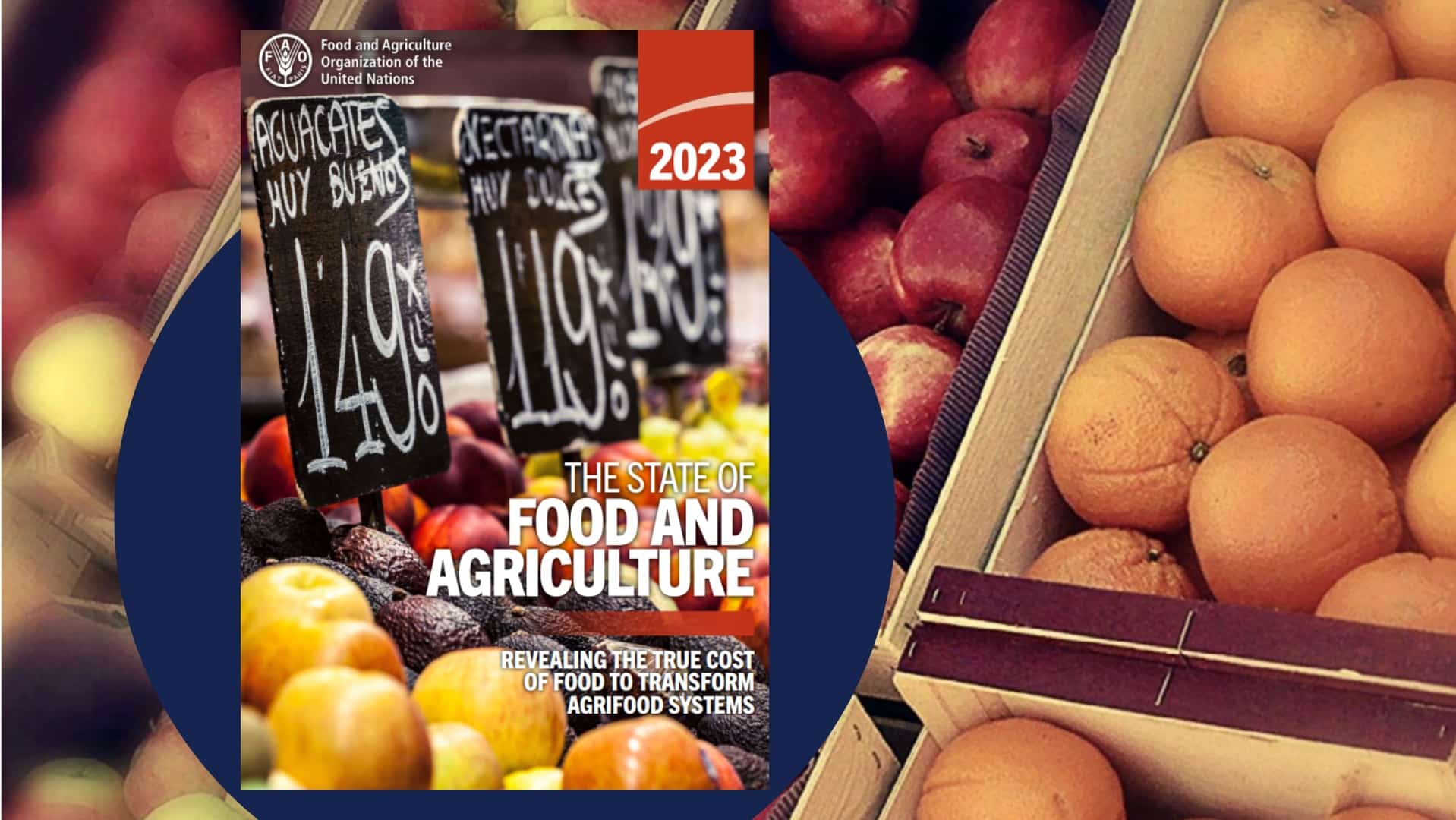What’s in Today’s Article?
- Why in News?
- What are Agri-Food Systems?
- About the State of Food and Agriculture 2023 Report
- Highlights of the State of Food and Agriculture 2023
- Improvements in Agricultural Productivity in India and its Adverse Impacts
- What is the Policy Environment in India and Issues with it?
- What can be Done to Help Farmers in India?
Why in News?
- The State of Food and Agriculture 2023 – a report from the UN Food and Agriculture Organisation (FAO), has revealed the massive hidden costs of the global agrifood systems, which exceed an astounding $10 trillion.
- In middle-income countries like India, these costs constitute nearly 11% of the GDP, which manifests as higher poverty, environmental harm and health-related impact (undernourishment, unhealthy dietary patterns, etc).
What are Agri-Food Systems?
- Agrifood systems have three main components:
- Primary production: It includes food from agricultural and non-agricultural origins.
- Food distribution: It links production to consumption through food supply chains and domestic food transport networks.
- Household consumption: It is the downstream outcome of functioning agrifood systems, subject to varying degrees of demand shocks.
About the State of Food and Agriculture 2023 Report
- This edition of the report introduces the concept of the hidden costs and benefits of agrifood systems and provides a framework through which these can be assessed.
- The report aims to initiate a process that will better prepare decision-makers for actions to steer agrifood systems towards environmental, social and economic sustainability.
Highlights of the State of Food and Agriculture 2023
- The report highlights massive hidden costs of the global agrifood systems, exceeding an astounding $10 trillion.
- The report blames unsustainable business-as-usual activities and practices for these escalating costs, pointing to a need to transform agrifood systems.
- One way to do so is to shift to multi-cropping systems that have the potential to protect farmers’ well-being, improve nutritional outcomes for the communities, and positively impact ecological health.
Improvements in Agricultural Productivity in India and its Adverse Impacts
- This has been achieved over the last five decades by mainstreaming monocropping systems and chemical-intensive farming practices.
- The Green Revolution focused credit on inputs and marketing of high-yielding varieties of paddy and wheat on agricultural lands, which now constitute more than 70% of India’s agricultural production.
- However, the infusion of seeds purchased from multinational corporations and fertilisers undermined seed sovereignty and dismantled Indigenous knowledge systems.
- This trend also compromised the nutritional needs of households and resulted in adverse ecological consequences including soil fertility and excessive extraction of groundwater.
- This privatisation and deregulation of agricultural inputs also increased indebtedness among agrarian households.
- In 2013, the debt to asset ratio of a farmer household in India was 630% higher than in 1992.
What is the Policy Environment in India and Issues with it?
- Under the National Food Security Act 2013, 65% of households (around 800 million people) in India are legally assured a right to food at subsidised rates through the Public Distribution System and welfare programmes such as –
- The Integrated Child Development Services and
- The Mid-Day Meal Scheme.
- The procurement of food crops: It is coordinated by the Food Corporation of India (FCI), which is required to maintain a central pool of buffer stock and to procure, store, transport, and maintain foodgrain stocks in the country.
- However, this procurement policy heavily favours rice and wheat.
- Not surprisingly, the area under cultivation of coarse grains dropped by 20% between 1966-1967 and 2017-2018.
- Policies favouring investments in water-intensive cash crops: Water-intensive cash crops like sugarcane and arecanut have flourished under policies –
- Favouring investments in dams and canal irrigation (favouring sugarcane) and
- Free electricity for borewells (favouring arecanut).
What can be Done to Help Farmers in India?
- A systemic shift in food regimes, from local to global value chains, is essential.
- Diversified multi-cropping systems, rooted in agroecology principles, could be a viable solution to revitalise degraded land and soil.
- Practices known by various names locally, like ‘akkadisaalu’ in Karnataka, involve intercropping with a combination of legumes, pulses, oilseeds, trees, shrubs, and livestock.
- Alternative farming systems may increase farmer’s income and improve the environment.
- For example, millets, whose yield per hectare is comparable to those of rice and wheat, are more nutritious and grow in semi-arid conditions without burdening groundwater tables.
- By redirecting subsidies, currently accruing to corporations, farmers can be paid for their contribution to sustaining natural capital, instead of incentivising them to deplete it.
Q1) What is the Food and Agriculture Organisation (FAO)?
The FAO is a specialised agency of the UN leading international efforts to defeat hunger. FAO’s goal is to achieve food and security for all and make sure that people have regular access to enough high-quality food and lead active, healthy lives.
Q2) What is the Pradhan Mantri Garib Kalyan Anna Yojana (PMGKAY)?
PMGKAY is a food security welfare scheme announced by the Government of India in 2020, during the COVID-19 pandemic in India. It was initiated to provide free food grains to the needy through ration shops under the NFSA.
Source: Feeding humans has trapped the world in debt, degradation: FAO report | Explained
Last updated on June, 2025
→ UPSC Notification 2025 was released on 22nd January 2025.
→ UPSC Prelims Result 2025 is out now for the CSE held on 25 May 2025.
→ UPSC Prelims Question Paper 2025 and Unofficial Prelims Answer Key 2025 are available now.
→ UPSC Calendar 2026 is released on 15th May, 2025.
→ The UPSC Vacancy 2025 were released 1129, out of which 979 were for UPSC CSE and remaining 150 are for UPSC IFoS.
→ UPSC Mains 2025 will be conducted on 22nd August 2025.
→ UPSC Prelims 2026 will be conducted on 24th May, 2026 & UPSC Mains 2026 will be conducted on 21st August 2026.
→ The UPSC Selection Process is of 3 stages-Prelims, Mains and Interview.
→ UPSC Result 2024 is released with latest UPSC Marksheet 2024. Check Now!
→ UPSC Toppers List 2024 is released now. Shakti Dubey is UPSC AIR 1 2024 Topper.
→ Also check Best IAS Coaching in Delhi
























